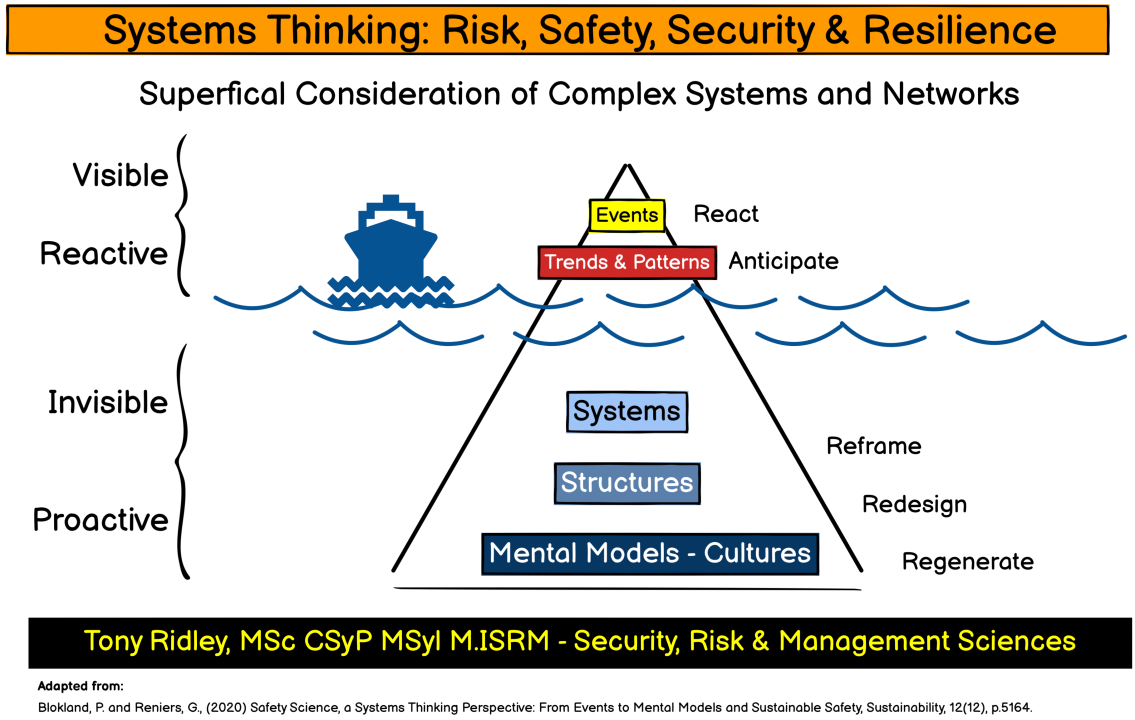
Risk, Safety, Security & Resilience: Concealed, complex and dynamic systems, structures and culture/s
Ridley Tony
Experienced Leader in Risk, Security, Resilience, Safety, and Management Sciences | PhD Candidate, Researcher and Scholar
Consideration of systems, structures, networks and mental models within the context of risk, safety, security and resilience routinely remains a superficial affair.
That is, what is most visible, tangible, recent or collectively agreed upon drives thinking or perceived understanding of the cause or origins of risk, harm, loss and damage.
In other words, when an event occurs, and the cause seems obvious and collectively agreed upon, there is little desire or apparent commitment to examine the underlying issues any further. In short, it's obvious... look no further!!
Like the proverbial iceberg, events, patterns and trends represent the mere tip of a very big issue, inclusive of complex networks, human decisions, power, group influence, community/culturally accepted action and inaction along with structures that service all these factors inconsistently and irregularly.
It is was lurks below the surface that creates outcomes, is often the most concern and least likely to be considered, resolved and most assuredly has changed in the time since last event or since last though of in any reasonable depth.
However, dramatic, obvious, newsworthy and collective consensus on what the 'problem' must be, leads to an extremely curated view and list of 'solutions', which are inherently reactive and limiting.
Systems analysis, complexity revision and diverse psychosocial factors is a difficult, specialist task.
As a result, most risk, resilience, safety and security functionaries avoid the practice and place little value in the process.
Hence the routine omission from pre/post event analysis.
Paradoxically, the 'system' that supports these glaring omissions continue on with false assumptions of knowledge, foresight and warnings until the next collision, accident, failure and disruption, constantly blaming a complex world, uncertain times or global volatility as a means of self rationalisation and delusion that they have any agency in contributing to the lack of investigation, comprehension or effort to look below the surface in any great detail.
In sum, events, trends, patterns and other seemingly observable outcomes related to risk, safety, security and resilience are inherently comprised of many moving parts, decisions, influences and factors.
领英推荐
It is these concealed, intangible and complex systems, interactions, structures and cultures that contribute significantly to not only negative but also positive outcomes.
Therefore, determining which one or collective group contributed to a specific event(s) required considerable evaluation, analysis and research.
As a result, assertions, solutions and 'ah ha' findings made within minutes, hours, days or even weeks remain questionable and implausible, no matter how comforting and popular.
In short, the greater complexity and systems associated with risk, resilience, safety and security, the greater insight, analysis and discovery is required.
In other words, superficial, dangerous views are the product of superficial, inadequate processes.
To fix both, you must change both.
A lack of detail, substance, research or analysis remains a telltale sign you are consuming the mere tip of a much larger iceberg.
Conversely, considered evaluation, detail, analysis and supporting evidence (hallmarks of professionals, science and good governance) indicates a more whole-of-problem approach.
While not infallible, greater reliance and confidence should be derived from the latter, not the former.
Ironically, liability, reputation damage and punitive recourse tend to circle the more superficial practices, findings and false confidence/advice.
Tony Ridley, MSc CSyP MSyI M.ISRM
Security, Risk, Resilience, Safety & Management Sciences
Simplifying Talent Processes, Championing Mental Wellbeing, Navigating Talent Complexity Risks
2 年Tony Ridley, MSc CSyP MSyI M.ISRM What you referring to is that the Iceberg as depicted is flawed. What's listed as proactive are reactive symptoms emerging as trends/ patterns with confirmation bias applied to 4-9% of problems known Conways Law's influences as Mental Models/Cultures are intangibles that invalidate its use at the base which leaders misinterpret Systems thinking has no provision for complexity inclusion or variance control in the pyramid, causing design to be flawed Systems /structures are linear by design, making provision for known knowns with a limitation on how it includes complex problems as it cannot address unsequential nonlinear events / processes Missing, as you stated is to include complexity and provision for #initial_condtions_sensitivity and extreme events Sensitivity to initial conditions being that system's behaviour may diverge rapidly from slightly different conditions, making them unpredictable. Cultures/ Mental Models do not represent/ include individual complexity, or provide for unpredictable behaviour This makes the complete systems reactive to symptoms that only emerge as events patterns devoid of proactive individual psychological safety - Impacts in attached David Fraser Akbar
Exploring new opportunities; big or small
2 年What if one get caught in choppy water? Stay Safe
This is good stuff. Your earlier post as well. Thank you sir. I’d be interested in your thoughts on the development of organic risk comprehension and risk modeling for organizations that do not have any, or under-developed, risk analysis and mitigation programs. Said another way, where does one start when a zero base approach is needed?